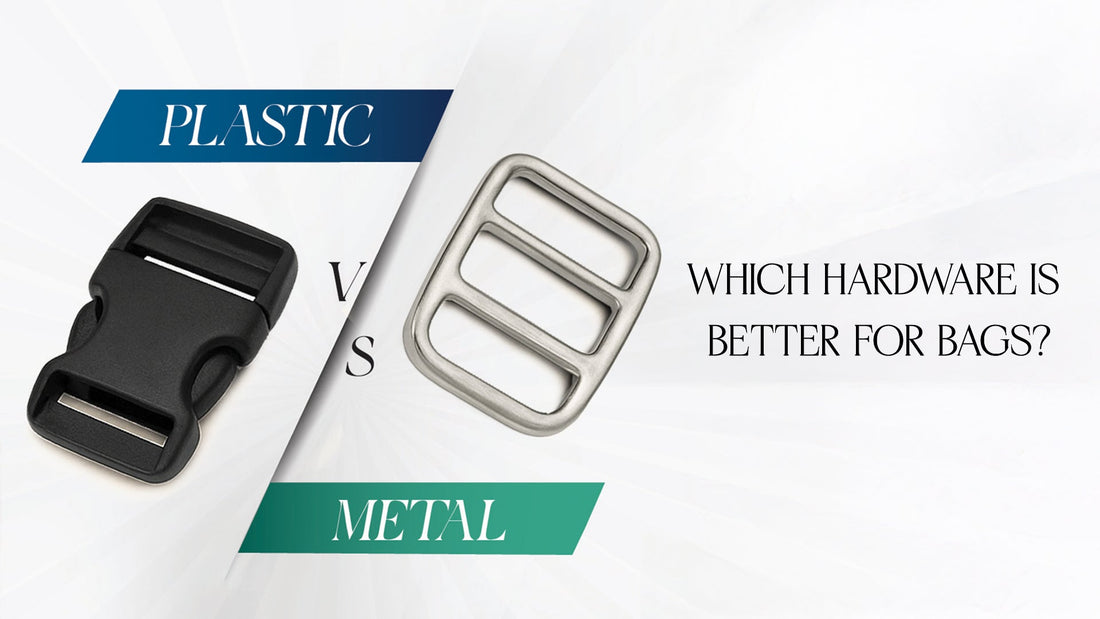Choosing the right hardware (buckles, clasps, chains, etc.) for bags and accessories is a balancing act between performance and brand image. Metal hardware – like stainless steel, brass, or zinc alloys – offers exceptional strength, toughness and a premium feel, while plastic hardware – typically high-grade polymers such as acetal, nylon or polypropylene – is ultra-lightweight and corrosion-resistant. Both materials have trade-offs. This article compares metal and plastic hardware in terms of durability, weight, aesthetics, sustainability, and manufacturing, to guide brands and product developers on the best choice for each market segment.
Durability and Stress Performance

Metal hardware is renowned for strength and longevity. High-quality metals (stainless steel, solid brass, zinc alloy) resist bending, wear and corrosion even under heavy loads[1]. A metal buckle or D-ring in a leather satchel will generally outlast plastic alternatives by years. By contrast, plastic hardware is lighter and often corrosion-proof, but it can crack or fatigue under extreme stress[1][2]. (For example, military-style gear uses metal clasps because “failure is not an option,” whereas plastic clips are reserved for lighter loads[2].) In practice, developers note that plastic buckles made from premium polymers (acetal or nylon) can handle normal use (backpacks, sport bags, children’s gear) and resist UV degradation, but they still tend to fail sooner under continuous strain[1][3].
· Metal hardware: Very high tensile strength; excellent wear resistance; holds up to rough handling[1][2]. Often used in high-end or heavy-duty bags.
· Plastic hardware: Adequate strength for light-to-medium use; flexible and corrosion-proof. But plastic can become brittle or deform if overloaded or used in extreme temperatures[1][3].
In summary, metal fittings tend to endure heavy use and stress far better than plastic, so they suit rugged or premium designs. Plastic hardware is fine for casual or budget products, but engineers must ensure load limits and test for wear (e.g. repeated buckle cycles or zipper pulls).
Weight and User Comfort

Bag hardware also affects how a product feels in use. Metal is typically heavier – solid brass or stainless parts can add noticeable weight. This is often acceptable for short-term or travel bags, but can make lightweight bags tiring over long periods. For example, steel chains or brass buckles can each weigh a few tens of grams, so a bag with many metal accents might feel significantly heavier on the shoulder[4]. In contrast, plastic hardware is extremely lightweight[5], which enhances all-day comfort. Many sports and kids’ bags use plastic buckles precisely to keep weight down.
· Metal: Heavier components (e.g. steel buckles, hardware chains) make a bag feel weightier[4]. Good for sturdy feel but can strain users if overused.
· Plastic: Incredibly light (often 50–70% lighter than comparable metal parts)[5]. Keeps bags easy to carry and is often preferred for travel or children’s products.
For bag designers, a mix often works: use metal where rigidity or a premium feel is needed, and plastic for adjustable sliders or hidden clips that benefit from lightness.
Aesthetic Impact and Brand Perception

Metal hardware usually conveys luxury and quality. Shiny or brushed metal parts catch the eye and suggest durability. Many fashion brands deliberately use metallic clasps, chains and buckles to reinforce a premium image[6][1]. For instance, gold- or silver-tone metal hardware is a signature on designer handbags. By contrast, plastic hardware tends to look more utilitarian or sporty. Its matte or bright-colored appearance signals a casual or budget product[7]. As design consultant Marcus Roffey notes, “genuine … metal have a higher perceived quality than equivalent plastics”[6]. In practice, a satchel with a metal latch will feel upscale, whereas a nylon pack with plastic clips feels utilitarian (both have their place in brand strategy).
· Metal: Presents a premium, “authentic” feel[6][1]. Often polished, plated or antique-finished to match brand style. Great for luxury and professional products.
· Plastic: Suggests practicality and modernity[7]. Allows bold colors and novel shapes. Common in sport, outdoor, or kids’ lines where lightweight and bright aesthetics matter.
Choosing hardware in line with brand positioning is key: luxury brands tend to use metal hardware to reinforce a high-end image, while mass-market or youthful brands can leverage plastic’s versatility and color without contradicting their price point.
Sustainability and Recyclability

Hardware materials also differ in environmental impact. Metals have a strong sustainability edge in recycling. Most metals (steel, aluminum, brass, zinc) can be recycled indefinitely without losing quality[8]. Recycling aluminum or steel saves huge energy (recycling aluminum uses ~95% less energy than mining new ore[9]) and prevents more mining. Metal parts are valuable scrap and widely collected. By contrast, plastics degrade during recycling: each cycle slightly lowers quality, and many hardware plastics (especially blends or coated pieces) are difficult to sort and recycle[8][10]. Global recycling rates for plastics are much lower than metals. In practice, discarded plastic hardware often ends up landfilled or incinerated.
· Metal: Highly recyclable (can be melted and reused repeatedly)[8]. Recycling metal hardware greatly reduces energy and mining impacts (e.g. ~95% energy savings for recycled aluminum[9]).
· Plastic: Limited recyclability; quality diminishes each loop[8]. Most bag plastics are downcycled or wasted. Producing new plastic hardware uses more fossil resources and emits more greenhouse gases.
Brands focused on eco-friendly messaging often emphasize recycled or recyclable metal hardware (recycled stainless steel, for example). Plastic hardware can incorporate recycled polymers, but recycling infrastructure is challenging. From a life-cycle view, metal hardware typically has the advantage, especially if reused or remanufactured.
Manufacturing Cost and Scalability

Production methods differ between metal and plastic hardware, affecting costs and scale. Plastic hardware is usually made by injection molding or extrusion, which has relatively low tooling costs. A single plastic mold can be relatively cheap, so small runs or frequent design changes are affordable[11]. Injection molding also allows complex shapes and quick cycles. However, plastics still incur costs (material, mold-making, machine time).
By contrast, metal hardware often requires stamping, die-casting or machining. The initial tooling (dies, molds, CNC programs) is usually expensive and time-consuming to make[12]. Metal parts may also need finishing (plating, polishing, painting), adding cost. As a result, metal hardware tends to have a higher per-piece price unless produced in very large volumes. In summary:
· Plastic (injection molding/extrusion): Lower upfront tooling cost; economical for short runs or custom colors[11]. Lower material cost per unit. Best for flexible production.
· Metal (stamping/machining): High tooling and setup cost; requires large batches to amortize[12]. Often heavier materials cost more. Yields high quality, but capital investment is higher.
Designers should consider order size and complexity. For a small batch of prototype or mid-tier accessories, plastic hardware is often cheaper and faster. For high-volume premium lines, metal hardware can be cost-competitive per unit, especially when factoring in the longevity and value it adds to the product.
Conclusion

In practice, the “right” material depends on product purpose and brand strategy:
· Choose metal hardware when durability and a premium feel are priorities. Ideal for heavy-duty backpacks, travel luggage, leather goods and luxury accessories. Metal’s strength justifies higher price points and reinforces a high-quality brand image.
· Choose plastic hardware when weight, cost, or casual style matter more. Good for outdoor gear, children's bags, sporty styles or budget-friendly products. Plastic clips and toggles keep products lightweight and accessible without undermining a utilitarian aesthetic.
Often the best solution is a mix: use metal for key visible pieces (zippers, locks, logo plates) to convey quality, and plastic for less-visible or adjustable parts (webbing buckles, interior fittings) to cut weight and cost. By aligning material choice with both performance needs and brand messaging, Crea can help its clients strike the right balance of durability, user experience and market positioning in their bags and accessories.
[1] [4] [5] [7] The Ultimate Guide To Bag Hardware Types In 2025: Everything You Need To Know | LESONDI
https://lesondi.com/bag-hardware-types/
[2] [3] Plastic Buckles vs. Metal Buckles: When to Use Each – A Guide by John Howard Company - John Howard Company
[6] Perceived Quality
[8] [9] [10] How Metal Recycling Differs From Plastic Recycling - Franklin Metals
https://franklinmetals.com/how-metal-recycling-differs-from-plastic-recycling/
[11] [12] Cost Comparison: Metal Stamping vs Injection Molding
https://www.sigmatechnik.com/injection-molding/cost-comparison-metal-stamping-vs-injection-molding

